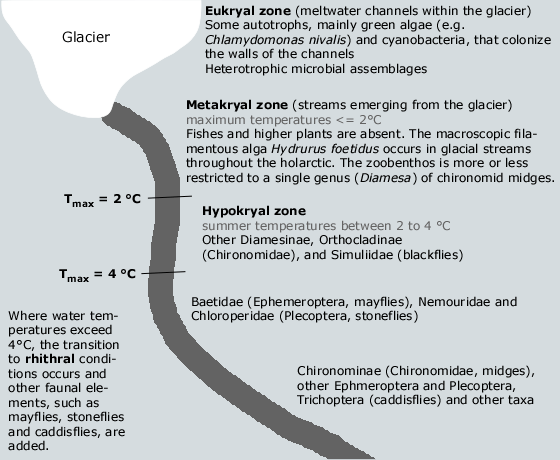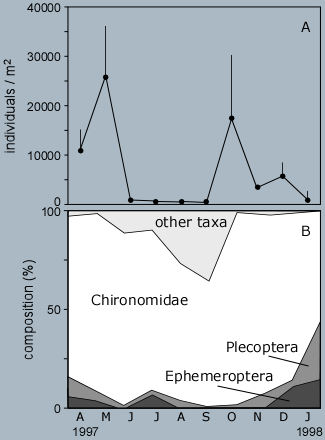 |
|
|
|
|
|
|
Longitudinal patterns |
|
In kryal streams, a characteristic downstream faunal change can be observed. In the first few metres below the glacier, normally no animals occur at all. In most northern hemisphere glacial streams, larvae of the chironomid Diamesa then appear in low densities and increase in abundance downstream. The algal assemblages of glacial streams are characterized by few taxa and a paucity of diatoms. Where Tmax exceeds about 2 °C is the transition from the Metakryal to the Hypokryal. The fauna is characterized by Diamesa and simuliids. It increases in abundance and diversity downstream, other Diamesinae, Simuliidae and Orthocladiinae typically may be present. Glacial brook elements decline in abundance. A marked shift in community composition usually occurs also at the transition from kryal to rhitrhal, where Tmax exceeds about 4 °C. Baetidae, Nemouridae and Chloroperlidae typically occur. Further downstream other Ephemeroptera, Plecoptera and Diptera, as well as Trichoptera, appear. |
1 - Characteristic zonation in a kryal stream in summer |
|
The environmental conditions within a stream depend not only on the distance from the glacier, but also on the contribution of non-glacial water sources and season. Downstream of the kryal segment, a glacio-rhithral zone, fed by a mixture of water sources, can extend for a considerable distance, with temporal changes in discharge and temperature. |
|
Seasonal patterns |
|
In kryal streams, flora and zoobenthos are not constant at a given location, but exhibit a high spatio-temporal variation due to seasonal shifts in glacial influence. Burgherr (2000) repeatedly measured the zoobenthos in a kryal stream between April 1997 and January 1998 (Fig. 2). He found large differences in zoobenthos abundance as well as composition, with peaks in spring and late autumn/early winter. These peaks coincide with a peak in benthic algae, especially the chrysophyte Hydrurus foetidus, enhancing food
availability for zoobenthic organisms. During these periods, stream beds are relatively stable, and sediment transport, shear
stress and turbidity are minimal. |
2 - Average abundance (A) and composition (B) of the zoobenthos in a kryal channel about 600 m below the Tschierva Glacier, Switzerland (after Burgherr 2000) |
29 August 2011 |
||
| |
||

